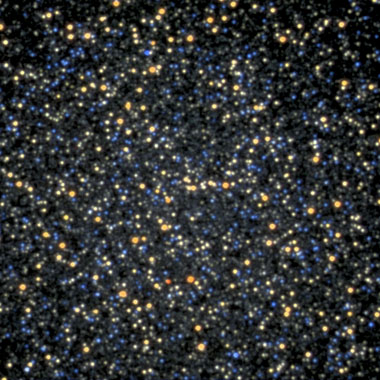

The center of the Globular Cluster Omega Centauri (NGC 5139)
| Date: | 27.03.97
| Time: | 7:19 UT
| Exposure: | B:60s, V:30s, R:30s
|
| Field of View: | 4' x 4'
| Receiver: | 5122 CCD
| Filter: | B, V, R
|
| Instrument: | 90cm Dutch
| Observatory: |
La Silla
| Observer: | S. Kohle
|
© Copyright by the observers

Astronomical Institutes of the University of Bonn
Omega Centauri is the largest known globular cluster in our Milky Way. It has a distance of 17000 lightyears and an absolute diameter of about 150 lightyears - in the sky it has more than the apparent size of our Moon and appears as a fuzzy star of 4th magnitude !
The image above is a nearly "true colour"
composite which shows only the central 20x20 lightyears of the clusters core.
The stellar density in the center is with approx. 180 stars/lightyear3 about 80000 times as high as in the solar neighbourhood. It is expected that many binary stars form in collisions of stars. The globular cluster 47 Tucanae has a central density which is more than 10 times as high as in Omega Centauri.
The different colours of the stars are due to their different types. We can distinguish "Red Giants" (orange color in the image above) , blue "Horizontal Branch" stars and faint grey "Main Sequence" stars. As the stars in Omega Centauri are expected to have all the same age the basic parameter which controls their evolution and change of colour is the mass of the star.
The age of Omega Centauri was estimated to 16 billion years, so it is one of the oldest objects in the universe.
more links:
SEDS page
References:
Alcaino & Liller: CCD photometry of Omega Centauri, 1987AJ.....94.1585A
Noble et al. :Main-sequence CCD photometry of the globular cluster Omega Centauri, 1991MNRAS.250..314N
Davies & Benz: A Stellar Audit: The Computation of Encounter Rates for 47 Tucanae and Omega Centauri, astro-ph/9507025
